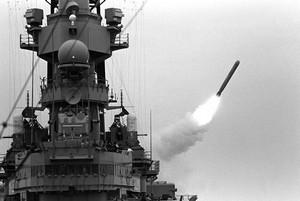SyriaWill the U.S. missile strike be the turning point in Syria’s shifting war?
The United States has struck the Syrian airbase used to launch a suspected sarin gas attack against Khan Sheikhun that killed more than eighty civilians. The rebel commander whose district was hit by the suspected chemical weapon attack has said he hopes the strike will be a “turning point” in the war — but the long-running conflict has had many such apparently pivotal moments. A shift of U.S. foreign policy on Syria could have been the game-changer. But the U.S. airstrike is more likely to reinforce the balance of power between the combating factions rather than lead to a turning point.

Tomahawk missile launched from seaborne platform // Source: commons.wikimedia.org
The United States has struck the Syrian airbase used to launch a suspected sarin gas attack against Khan Sheikhun that killed more than eighty civilians. U.S. President Donald Trump and Secretary of State Rex Tillerson cited the chemical attack as the reason for their country’s first direct involvement in Syria’s six-year war.
A Pentagon spokesman said Russia was informed ahead of the attack on the al-Shayrat airbase. According to the Associated Press, opposition group the Syrian Coalition, has welcomed the intervention. The rebel commander whose district was hit by the suspected chemical weapon attack has said he hopes the strike will be a “turning point” in the war.
But the long-running conflict has had many such apparently pivotal moments.
The fall of Aleppo
By the end of 2016, for instance, opposition forces in the Syrian city of Aleppo had been overwhelmingly defeated, raising doubts about their ability to endure the fight against the Assad regime. Especially as the latter receives active support from the Russian government and Shi’a militias.
The battle of Aleppo, much like the Battle of Stalingrad in the second world war, was characterized by close-quarters combat, massive displacement, great destruction and recurring air raids on civilian populations and infrastructure.
Scholars and researchers were largely divided after the Aleppo assault. Some viewed the outcome as the beginning of the end for the losing party – the Stalingrad moment of the Syrian war. Others recognized the importance of the events without considering them decisive.
And, like the U.S. missile strike, the suspected chemical attack on 5 April was perceived as another watershed moment. But, on the ground, the question is how these critical moments will shape the immediate options of warring factions.
Recent military developments in Hama and Damascus might indicate the direction the war is taking, with the rebels trying to recover from the battle of Aleppo and launching new offensives.
Aftermath the fall
After their defeat in Aleppo, many opposition groups reconsidered their inter-factional alliances. In the Idlib governorate and the countryside around Aleppo, for instance, a number of factions merged with what used to be known as the Nusra Front, or Jabhat Fath el-Sham, to form the new Hay’at Tahrir al-Sham.
Simultaneously, Ahrar al-Sham, one of the most powerful opposition groups in Syria, was absorbing other factions in the northwest.
